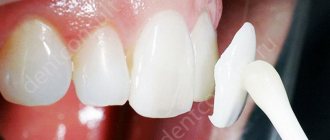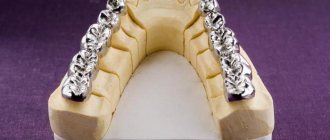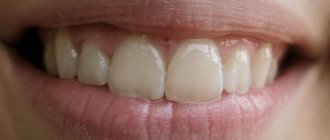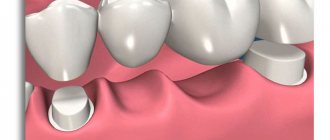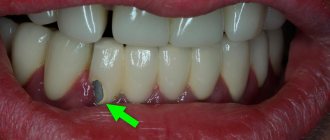- Service life of different types of crowns
- Late crown replacement
- When to change a crown
- How to change crowns
- How often are crowns replaced?
- Additional videos
Sooner or later, most people have to deal with dental prosthetics.
Perhaps the most common type of prosthetics is the so-called “dental crown” (more information about different crowns here). Many patients are their owners, but only a few patients ask questions: do dental crowns need to be replaced, how often should dental crowns be changed, etc.
Let's try to figure it out.
Content:
- Features of metal-ceramic crowns per tooth
- The need to install a metal-ceramic crown on a tooth
- The procedure for manufacturing metal-ceramic structures for teeth
- The procedure for installing a metal-ceramic crown on a tooth
- Rules for caring for metal-ceramic crowns
- Repair procedures for metal-ceramic crowns on teeth
A metal-ceramic tooth crown consists of two parts: metal and ceramic, respectively. Unhealthy teeth cause great discomfort and require the help of a specialist. When it is impossible to restore the original shape of teeth for a long time by filling, doctors suggest installing crowns. Metal-ceramic products are the best option for restoring teeth. The first layer is metal, it is responsible for the chewing function; ceramics are thinly applied to it. This coating does not cause allergic reactions, so it is suitable for most patients. The procedure is carried out by highly qualified specialists with experience. The quality of work on installing a crown on a metal-ceramic tooth is ensured by modern equipment and original materials.
Ceramic coating
The metal frame of the orthopedic structure is covered with a layer of dental ceramics, which in composition is almost similar to household ceramics, however, the compositions for lining metal-ceramic crowns contain an increased content of components such as albite and orthoclase, which increase the strength of the created layer.
The ceramics are applied to the frame in layers and specialists use a special tool for this work. After applying the next layer, the structure is fired in a vacuum oven. This is necessary to ensure the strongest possible adhesion of the ceramic layer to the frame.
Reviews of metal-ceramic crowns from patients indicate that this type of dental orthopedic structures is not only strong and durable, but also highly aesthetic, which makes it possible to regain an attractive and natural smile!
Features of metal-ceramic tooth crowns
Such products can serve uninterruptedly for more than ten years; with the correct load during chewing, high-quality installation, and proper care, the period increases.
The manufacture of prostheses requires professional knowledge, materials whose quality is confirmed by a certificate, and laboratory conditions. By observing all the required standards, prosthetics will be completely safe for the client.
Despite the fact that metal-ceramic crowns do not emit toxic substances during use, they can behave in different ways in the mouth, each case is individual. A frame made of nickel or chromium-nickel alloy can cause allergies if the structure is based on a base metal; it will oxidize over time when in contact with saliva.
The high strength of the crowns allows for greater loads when chewing. Due to their aesthetic appearance, the products are often installed to cover the front teeth, as well as premolars and molars.
The metal-ceramic crown is highly durable, does not wear off and is not subject to carious changes.
There are cases of puncture, to eliminate the problem there is no need to remove the product; specialists correct the prosthesis in the oral cavity.
One of the disadvantages is the high degree of grinding of the abutment tooth. Most often, the tooth is depulped and the root canals are filled. In this case, it is necessary to remove the nerve to avoid burns to the pulp.
Making a crown for a tooth from metal-ceramics
Advantages of metal-ceramic crowns
- high aesthetics;
- reasonable cost;
- strength, durability;
- resistance of ceramic mass to caries.
Ceramic metal is a compromise between aesthetics, strength and durability. Metal-free ceramics are much more expensive, and they are used mainly for prosthetics of teeth included in the smile area. The metal frame inside the metal ceramics gives the entire structure high strength and resistance to increased chewing loads.
The need to install a crown on a metal-ceramic tooth
It is advisable to install a metal-ceramic crown to restore a tooth that cannot be restored with filling, for installation on an implant, and also when tooth enamel is highly abrasive. Such prostheses can serve as a replacement for previous metal or plastic ones.
Metal-ceramics restores the natural shape of teeth with high precision and is almost the same in shape and texture. After prosthetics, the patient does not feel discomfort, there are no defects in speech and chewing function. It is practiced to install metal-ceramic dentures on teeth and crowns in the complete absence of dentition. The introduction of crowns is advisable regardless of the type of tooth.
Due to the hygiene and material, the crown is resistant to the influence of pathological microflora, bacteria, and fungi.
In case of abnormalities in the development of the dentition, if inlays or veneers are contraindicated, a crown will be the best option.
During operation, the prosthesis does not change color and is not affected by natural pigments, food coloring, nicotine, caffeine, etc.
Contraindications include:
- allergic reactions to product materials;
- periodontal disease and severe periodontitis;
- malocclusion;
- bruxism;
- low set teeth;
- excessive tooth mobility.
To avoid unwanted reactions and consequences after installing a prosthesis, you must carefully read the contraindications.
Making a crown on a tooth, before and after photos
Free consultation on the cost of treatment in our dentistry
Leave a request and the clinic administrator will contact you within 15 minutes!
Preparatory stage:
1. The patient comes for examination to a specialist. After assessing the condition of the tooth and a series of studies, the dentist makes a decision on the prosthetic technique.
2. If the root part of the tooth is alive, then it is possible to carry out a series of therapeutic manipulations, during which the specialist eliminates all inflammatory and destructive processes, if necessary, the dental canals are re-filled and a pin is applied.
If the tooth root is significantly weakened, then the pin cannot be used, and in this case, before installing a metal-ceramic crown, the specialist uses a stump spacer, designed to replace bone tissue that has undergone the process of destruction.
3. If the root of a tooth is missing or severely damaged, a dental implant must be installed. A metal-ceramic crown on an implant will cost more than other options, but this type of prosthesis has maximum durability and strength and is visually indistinguishable from natural teeth.
After all clinical training activities are completed, the second stage of prosthetics begins - laboratory.
Laboratory stage of installation of metal-ceramic crowns:
During the laboratory stage of prosthetics with metal-ceramic crowns, the structure itself is manufactured. The process consists of the following stages:
- Taking impressions of the patient’s teeth;
- Modeling of the structure frame;
- Trying on the finished prosthesis;
- Correction of possible defects.
The process ends with the installation and fixation of a metal-ceramic crown.
The procedure for making crown structures for teeth made of metal-ceramics
- Before proceeding with crown modeling, the client is prescribed a series of laboratory examinations. To install a prosthesis, the patient's oral cavity must be completely healthy. Found open cavities are filled and professional cleaning is prescribed.
- Based on the results of the preparatory period, you can begin selecting the product. Some are known for their durability, while others come with more than a year's warranty.
- The production of the prosthesis is carried out in laboratory conditions in stages.
- To obtain a high-quality impression, the doctor carries out a procedure for preparing the supporting part of the chewing element. After which you can make a two-layer print. Then, permanent fixations or bridges are installed in place of the prepared teeth. The dentist must determine the center of closure of the dental system.
- The one-piece metal crown frame is precisely adjusted to size, and the ceramic veneer is selected to match the color of the patient’s teeth.
Technological aspects of metal ceramics
In the process of manufacturing metal-ceramic structures, there are a number of key points that deserve special attention.
Tooth preparation for metal ceramics.
- The tooth must be prepared (ground) with a ledge at the gum level.
- The total thickness of the metal frame and the ceramic mass covering it is about 1.5 mm. As a result, if the tooth is ground without a ledge, we get the edge of the crown hanging over the gum and pressing on it. The crown presses against the blood vessels and a “bruise” forms. The metal frame comes into direct contact with the gum, and metal ions cause it to darken.
- In the case of preparation with a shoulder, the edge of the metal-ceramic crown rests on the hard tissues of the tooth without injuring the mucous membrane. This technology is quite labor-intensive, and its implementation requires a modern dental unit and, of course, the qualifications of a doctor and dental technician.
The intermediate part of the metal-ceramic bridge prosthesis should also not put pressure on the mucous membrane (gum), otherwise bedsores may form. Of course, in those places where it is visible, you have to make a compromise, but in any case the touch should be very gentle. And if food gets into a place where there is a loose seal, it will be much easier to remove it from there than in the case of the “full contact” option.
Many doctors “sin” by depulping (removing the nerve of the tooth) even healthy teeth under metal-ceramics, which is not always justified, since modern technologies make it possible in many cases to avoid this procedure. Depulped (dead) teeth cannot resist infection and often have to be re-treated. In addition, a pulpless tooth becomes more fragile and can collapse under a heavy metal-ceramic structure.
The procedure for installing a crown on a metal-ceramic tooth
After the preparatory procedures, the tooth must be sharpened to the size of the crown. An orthopedic dentist takes an impression to form a model of the prosthesis. The actual production of the crown is performed by a dental technician in a dental laboratory.
Typically, a crown on a tooth takes time to produce. Before receiving a permanent prosthesis, the client must visit a specialist at least three times. The duration of the entire process is from seven to ten days, not taking into account the treatment time.
While the permanent crowns are being made, the client will have a temporary plastic crown installed. This is necessary to protect the implant or ground tooth from the influence of food and saliva.
After trying on the finished product, if the patient is comfortable with the prosthesis, it is attached to the implant using a special solution.
Making a crown for a tooth from metal-ceramics
Stages of dental prosthetics
Rarely does dental prosthetics happen in a single stage; generally, it is a sequential, multi-stage process. After preliminary endodontic treatment, it is necessary to restore the supporting teeth using inlays or pins. Then the doctor prepares (grinds) them to create a place for the prosthetic structure, takes impressions from both jaws and the prosthetic area, and determines the color of the artificial teeth. A very important step in prosthetics is determining the occlusion (the relationship of the jaws), which allows you not to interfere with the prosthesis during chewing. The impressions are sent to the dental laboratory. This is a kind of information for a dental technician about the shape and size of the teeth, the anatomical features of the prosthetic bed, the location and type of structure. Based on the impressions obtained, the dental technician casts diagnostic and working models from plaster, which are an exact copy of the teeth, and in the case of complete edentia, the gums. Next, the structure itself is modeled with wax and the prosthesis itself is created using various methods and techniques. Sometimes during its manufacture it requires checking, fitting and fitting. The finished structure is fixed in the oral cavity. In some cases, additional correction of the prosthesis is required during the adaptation period.
Rules for caring for a metal-ceramic tooth crown
- Fixed dentures (crowns) do not require individual care; standard hygiene procedures are sufficient. It is mandatory to brush your teeth in the morning and evening, just before bed. It is advisable to use special rinses to clean the mouth.
- The toothbrush should be soft and not injure the gums. It is recommended to use dental floss to remove food debris and plaque.
- For preventive purposes, it is recommended to remove tartar once every six months and grind high points on the dentures in a clinical setting.
- At the first sign of pain, you should visit a doctor. The cause of pain may be the onset of a new pathology or poor-quality installation of a metal-ceramic prosthesis.
- Clients should be aware that when undergoing an MRI, if necessary, the prosthesis may appear as a defect in the image, so they should inform the doctor about the presence of a crown before the procedure.
Repair procedures for a metal-ceramic tooth crown
A common problem that patients present with is the occurrence of chips on their dentures. The restoration procedure depends on the size of the defect and how deep it is. Common cases are as follows:
- small nicks are removed quickly. The dentist polishes the chipped edges, processes them, and this completes the procedure;
- a medium to large nick, if the metal frame is not affected, requires restoration of the ceramic layer. The specialist uses a gel composite to restore the ceramics, selected by color. Polishing and grinding are carried out;
- in cases where the metal layer is exposed, the application of a metal frame is required. Opaque is applied, after which the ceramic layer is restored;
- cracks in the metal frame of the crown require complete replacement.
Metal-ceramic crowns are considered the most popular type of prosthetics. If you visit the dentist once every six months and take proper care of your oral cavity, the life of the crowns will be long, without the occurrence of defects.
The price of such a metal-ceramic crown directly depends on many components: the cost of the metal alloy from which the frame is made, the cost of the ceramic layer, payment for the work of the dentist, dental technician, patient characteristics, and the cost of additional services. Therefore, the cost is calculated for each case individually.
Service life of metal-ceramic crowns
Metal-ceramic crowns have a long service life, which reaches up to 8-10 years. Whether the prosthesis will last that long depends on the quality of the work of the prosthetist, dental technician, as well as on the behavior of the patient himself. Insufficient oral care worsens the cariogenic situation, increases the risk of developing caries and acute inflammatory process, including under an artificial crown.
The Yusodent dental clinic provides a guarantee for prosthetics, which lasts for 1 year. This period is usually enough to identify inflammatory processes and technical errors of a specialist. If immediately after installing the crown or a few weeks after this, signs of inflammation appear (redness, pain, swelling of the mucous membrane), or a large distance appears between the gum and the crown, immediately contact the clinic, the doctor who performed the prosthetics. A specialist will understand the situation and correct any mistakes.

